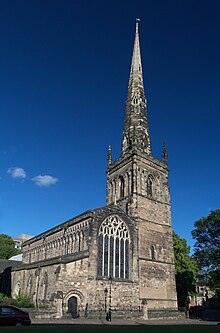St Mary de Castro (Leicester)
| St Mary de Castro, Leicester | |
|---|---|

St Mary de Castro, Leicester (prior to demolition of the spire)
|
|
| 52°37′56″N 1°08′25″W / 52.6323°N 1.1404°WCoordinates: 52°37′56″N 1°08′25″W / 52.6323°N 1.1404°W | |
| Denomination | Church of England |
| Churchmanship | Anglo-Catholic |
| Website | stmarydecastro.org.uk |
| History | |
| Dedication | St Mary de Castro "St Mary of the Castle" |
| Administration | |
| Parish | Leicester |
| Diocese | Leicester |
| Province | Canterbury |
|
Listed Building – Grade I
|
|
| Designated | 1950 |
| Reference no. | 1074070 |
St Mary de Castro is an ancient, Grade I listed church in Leicester, England, located within the former bailey of Leicester Castle. Today it acts as a parish church in the Church of England's diocese of Leicester. "St Mary de Castro" is Latin for "St Mary of the Castle"; a name chosen to differentiate from nearby "St Mary de Pratis": "St. Mary of the Meadows".
The building was closed in 2011 to the public after the spire was found to be unsafe but as of April 2015 is open again. The spire has been demolished, and funds are currently insufficient to replace it and repair the tower beneath.
It is believed to have been the first church in the UK to be viewable online using Google Streetview, having been photographed in August 2012.
It dates its founding to 1107 after Henry I of England granted the lands and castle to Robert de Beaumont, although Henry Knighton implies that an Anglo-Saxon college of St Mary had existed and Robert merely refurbished it. Robert established it within the castle bailey as a college served by a Dean and 12 Canons (that is, a collegiate church) in honour of the Virgin Mary and All Souls and as a chantry chapel for the souls of him, his family and the first three Norman kings. He endowed this and four other churches with £6 of his income and land in or near the city. However, in 1143 these endowments were all transferred by his son Robert le Bossu, 2nd Earl of Leicester, to his own new Augustinian foundation of Leicester Abbey. The collegiate church retained, or had restored to it a Dean, six Clerks and a Chaplain, along with Robert de Beaumont's grant of 20 shillings for lamps. It also retained parish offerings and most of the tithes. The collegiate nature of the church lasted until the college was disbanded in 1548 under the Chantry act of Edward VI.
...
Wikipedia
